Exploring Qualitative Research & Questionnaire Design in Management
VerifiedAdded on 2023/06/12
|13
|2950
|67
Report
AI Summary
This report delves into research methods in management, focusing on qualitative research and questionnaire design. It examines the strengths and weaknesses of qualitative research, illustrating when a qualitative research design is appropriate with examples. The report also discusses the attributes of a good questionnaire and the primary threats to the validity and reliability of data collected through questionnaires. Furthermore, it includes a specific research question related to talent management strategies and provides a brief questionnaire designed to gather relevant information for analysis, emphasizing the roles and responsibilities of managers in implementing these strategies for employee development.
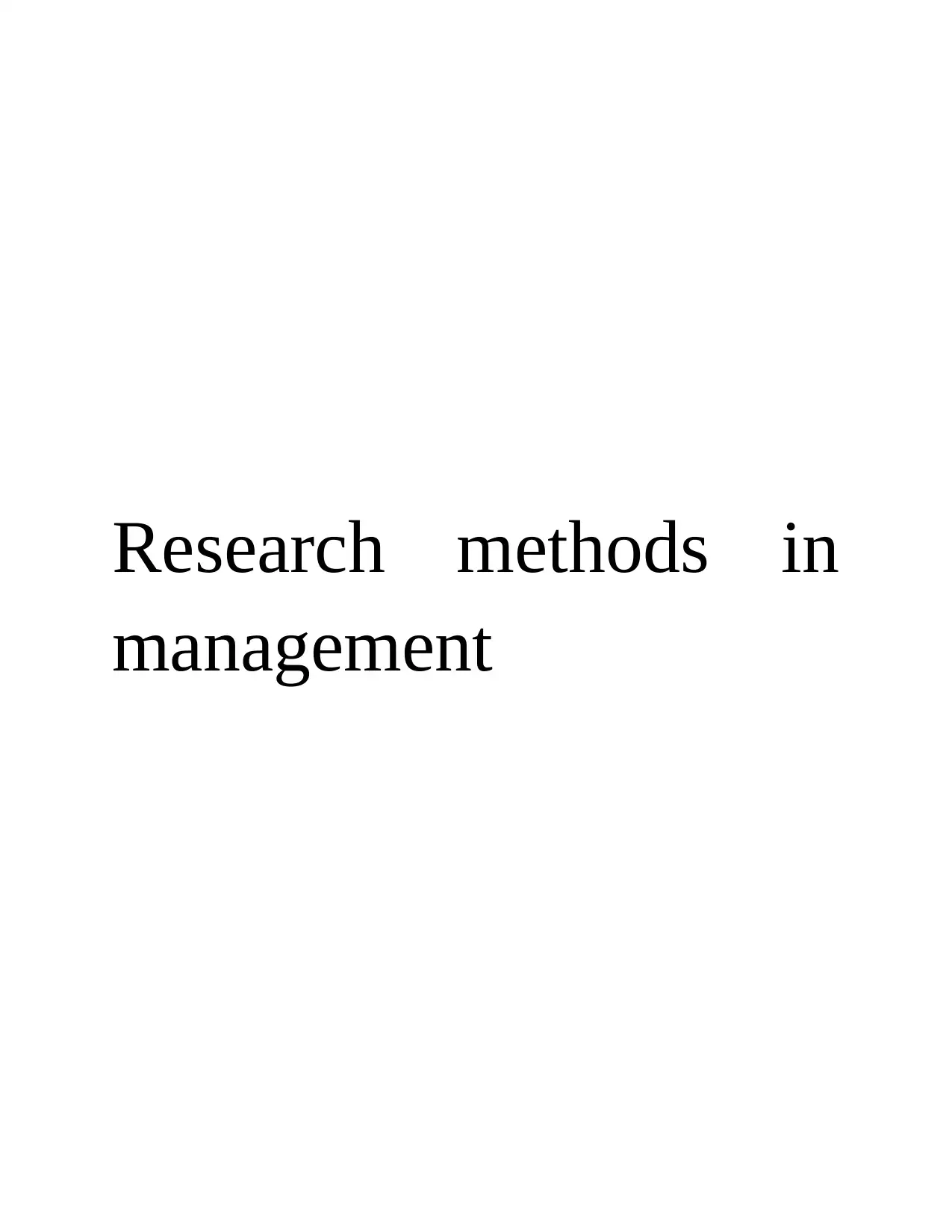
Research methods in
management
management
Paraphrase This Document
Need a fresh take? Get an instant paraphrase of this document with our AI Paraphraser
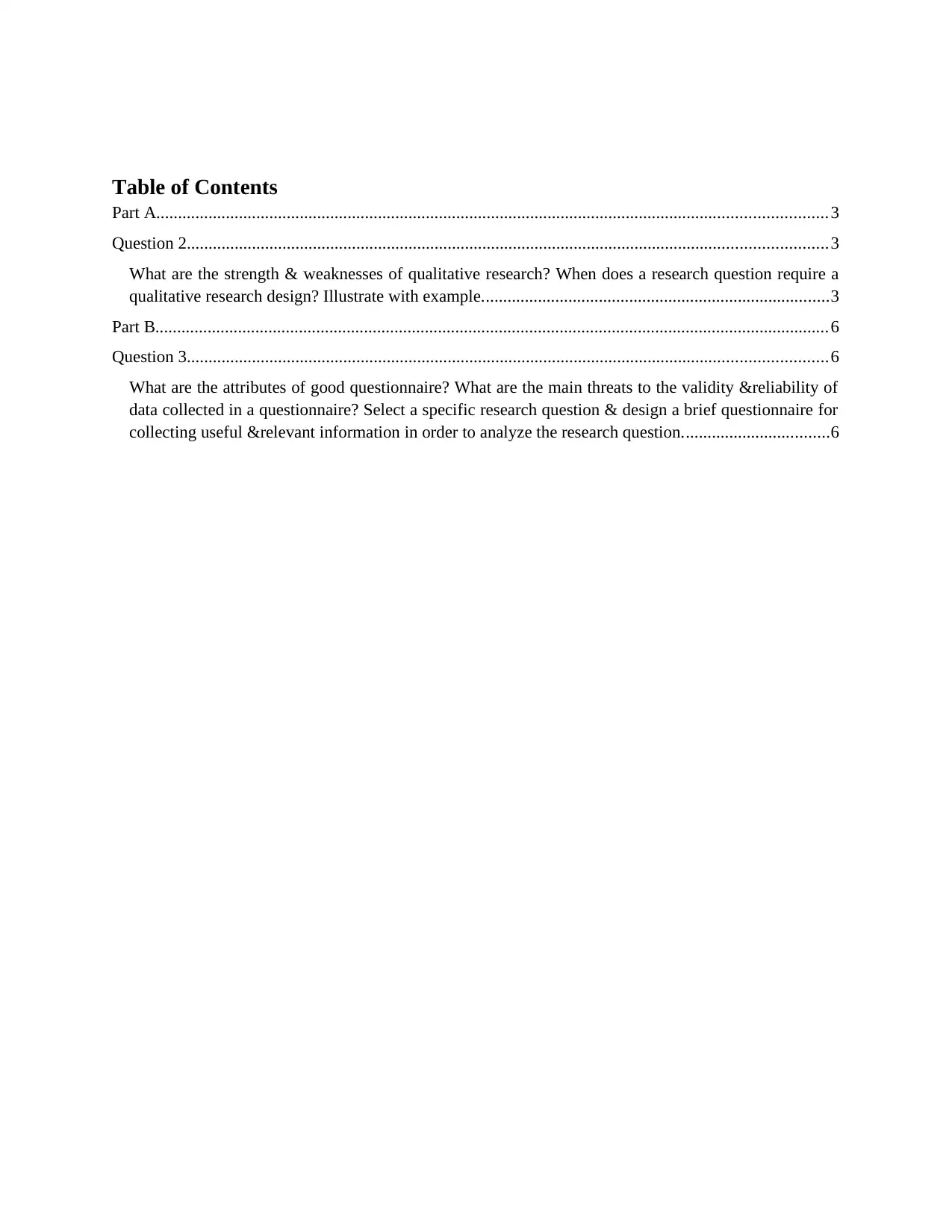
Table of Contents
Part A..........................................................................................................................................................3
Question 2...................................................................................................................................................3
What are the strength & weaknesses of qualitative research? When does a research question require a
qualitative research design? Illustrate with example................................................................................3
Part B...........................................................................................................................................................6
Question 3...................................................................................................................................................6
What are the attributes of good questionnaire? What are the main threats to the validity &reliability of
data collected in a questionnaire? Select a specific research question & design a brief questionnaire for
collecting useful &relevant information in order to analyze the research question..................................6
Part A..........................................................................................................................................................3
Question 2...................................................................................................................................................3
What are the strength & weaknesses of qualitative research? When does a research question require a
qualitative research design? Illustrate with example................................................................................3
Part B...........................................................................................................................................................6
Question 3...................................................................................................................................................6
What are the attributes of good questionnaire? What are the main threats to the validity &reliability of
data collected in a questionnaire? Select a specific research question & design a brief questionnaire for
collecting useful &relevant information in order to analyze the research question..................................6

Part A
Question 2
What are the strength & weaknesses of qualitative research? When does a research
question require a qualitative research design? Illustrate with example.
Qualitative research
The researcher is using the quantitative research approach to conduct the present inquiry since it
gives quantifiable data. It aids in the analysis of data &numbers pertaining to a study issue. The
fundamental motivation for using the quantitative technique is to gain a deeper understanding of
the social issues. The investigator can use this strategy to monitor circumstances & also events
that directly influence individuals. It also develops or generates objective data that may be shared
or analyzed using data & also statistics (Bresler and Stake,2017). A quantitative study will also
give the appropriate sample size, summary statistics for the variables included in the
investigation, &statistical significance. Authentic &dependable findings may be obtained as a
consequence of this, which may reduce the chance of obtaining improper data for the study goal.
As a consequence, the investigator employs the quantitative research design, which aids in the
measurement of findings by examining actual information regarding the study issue.
Strengths
Adaptability – Qualitative data can alter on the fly as individuals' reactions &replies are
received. Investigators can question responders why particular goods appeal to them
more often than others as a study session progresses, providing the firm a better grasp of
its consumers' thoughts of their products.
Captures New Beliefs – Qualitative research methodologies extrapolate any changing
economic beliefs. This might contain information like as who consumes a goods or how
workers feel about their bosses.
Question 2
What are the strength & weaknesses of qualitative research? When does a research
question require a qualitative research design? Illustrate with example.
Qualitative research
The researcher is using the quantitative research approach to conduct the present inquiry since it
gives quantifiable data. It aids in the analysis of data &numbers pertaining to a study issue. The
fundamental motivation for using the quantitative technique is to gain a deeper understanding of
the social issues. The investigator can use this strategy to monitor circumstances & also events
that directly influence individuals. It also develops or generates objective data that may be shared
or analyzed using data & also statistics (Bresler and Stake,2017). A quantitative study will also
give the appropriate sample size, summary statistics for the variables included in the
investigation, &statistical significance. Authentic &dependable findings may be obtained as a
consequence of this, which may reduce the chance of obtaining improper data for the study goal.
As a consequence, the investigator employs the quantitative research design, which aids in the
measurement of findings by examining actual information regarding the study issue.
Strengths
Adaptability – Qualitative data can alter on the fly as individuals' reactions &replies are
received. Investigators can question responders why particular goods appeal to them
more often than others as a study session progresses, providing the firm a better grasp of
its consumers' thoughts of their products.
Captures New Beliefs – Qualitative research methodologies extrapolate any changing
economic beliefs. This might contain information like as who consumes a goods or how
workers feel about their bosses.
⊘ This is a preview!⊘
Do you want full access?
Subscribe today to unlock all pages.

Trusted by 1+ million students worldwide
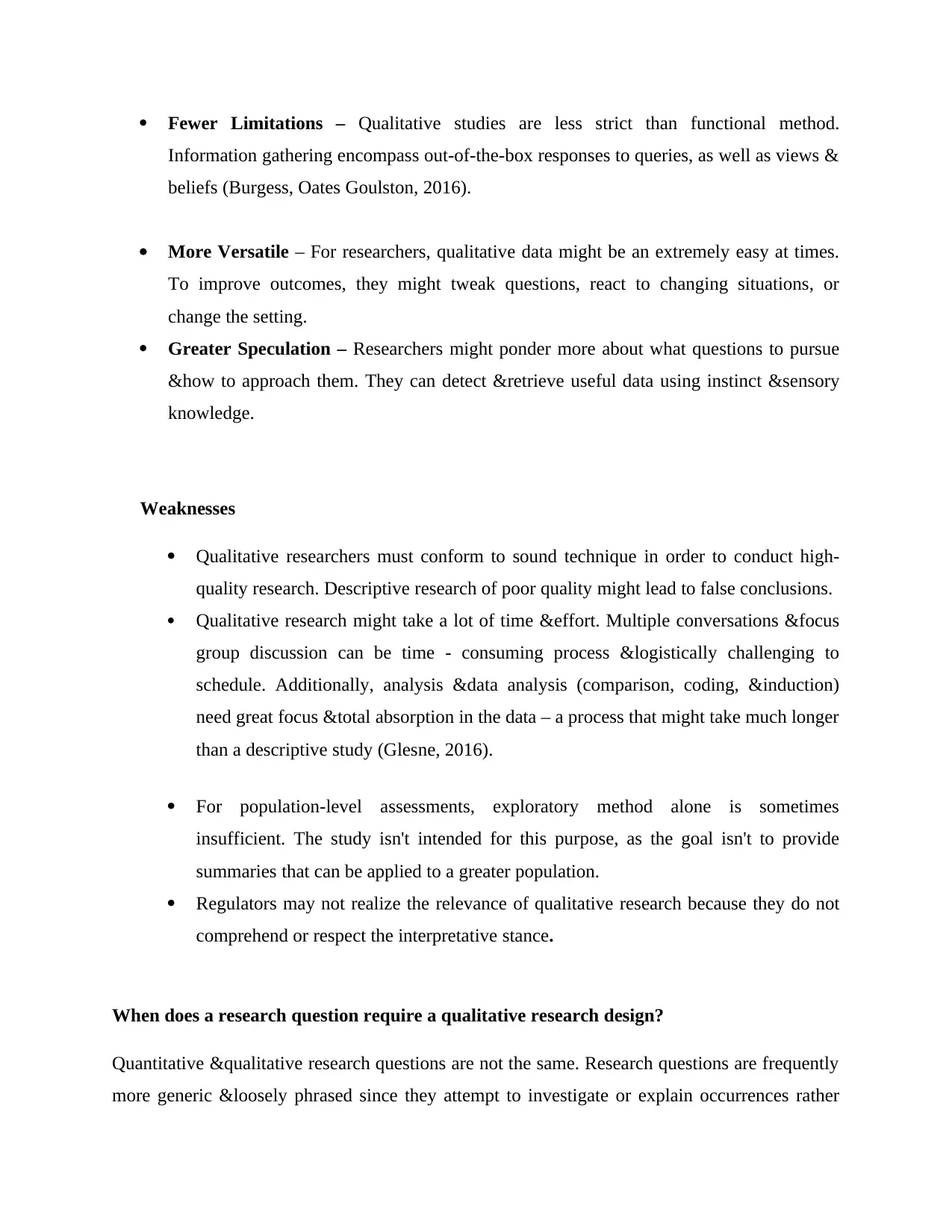
Fewer Limitations – Qualitative studies are less strict than functional method.
Information gathering encompass out-of-the-box responses to queries, as well as views &
beliefs (Burgess, Oates Goulston, 2016).
More Versatile – For researchers, qualitative data might be an extremely easy at times.
To improve outcomes, they might tweak questions, react to changing situations, or
change the setting.
Greater Speculation – Researchers might ponder more about what questions to pursue
&how to approach them. They can detect &retrieve useful data using instinct &sensory
knowledge.
Weaknesses
Qualitative researchers must conform to sound technique in order to conduct high-
quality research. Descriptive research of poor quality might lead to false conclusions.
Qualitative research might take a lot of time &effort. Multiple conversations &focus
group discussion can be time - consuming process &logistically challenging to
schedule. Additionally, analysis &data analysis (comparison, coding, &induction)
need great focus &total absorption in the data – a process that might take much longer
than a descriptive study (Glesne, 2016).
For population-level assessments, exploratory method alone is sometimes
insufficient. The study isn't intended for this purpose, as the goal isn't to provide
summaries that can be applied to a greater population.
Regulators may not realize the relevance of qualitative research because they do not
comprehend or respect the interpretative stance.
When does a research question require a qualitative research design?
Quantitative &qualitative research questions are not the same. Research questions are frequently
more generic &loosely phrased since they attempt to investigate or explain occurrences rather
Information gathering encompass out-of-the-box responses to queries, as well as views &
beliefs (Burgess, Oates Goulston, 2016).
More Versatile – For researchers, qualitative data might be an extremely easy at times.
To improve outcomes, they might tweak questions, react to changing situations, or
change the setting.
Greater Speculation – Researchers might ponder more about what questions to pursue
&how to approach them. They can detect &retrieve useful data using instinct &sensory
knowledge.
Weaknesses
Qualitative researchers must conform to sound technique in order to conduct high-
quality research. Descriptive research of poor quality might lead to false conclusions.
Qualitative research might take a lot of time &effort. Multiple conversations &focus
group discussion can be time - consuming process &logistically challenging to
schedule. Additionally, analysis &data analysis (comparison, coding, &induction)
need great focus &total absorption in the data – a process that might take much longer
than a descriptive study (Glesne, 2016).
For population-level assessments, exploratory method alone is sometimes
insufficient. The study isn't intended for this purpose, as the goal isn't to provide
summaries that can be applied to a greater population.
Regulators may not realize the relevance of qualitative research because they do not
comprehend or respect the interpretative stance.
When does a research question require a qualitative research design?
Quantitative &qualitative research questions are not the same. Research questions are frequently
more generic &loosely phrased since they attempt to investigate or explain occurrences rather
Paraphrase This Document
Need a fresh take? Get an instant paraphrase of this document with our AI Paraphraser
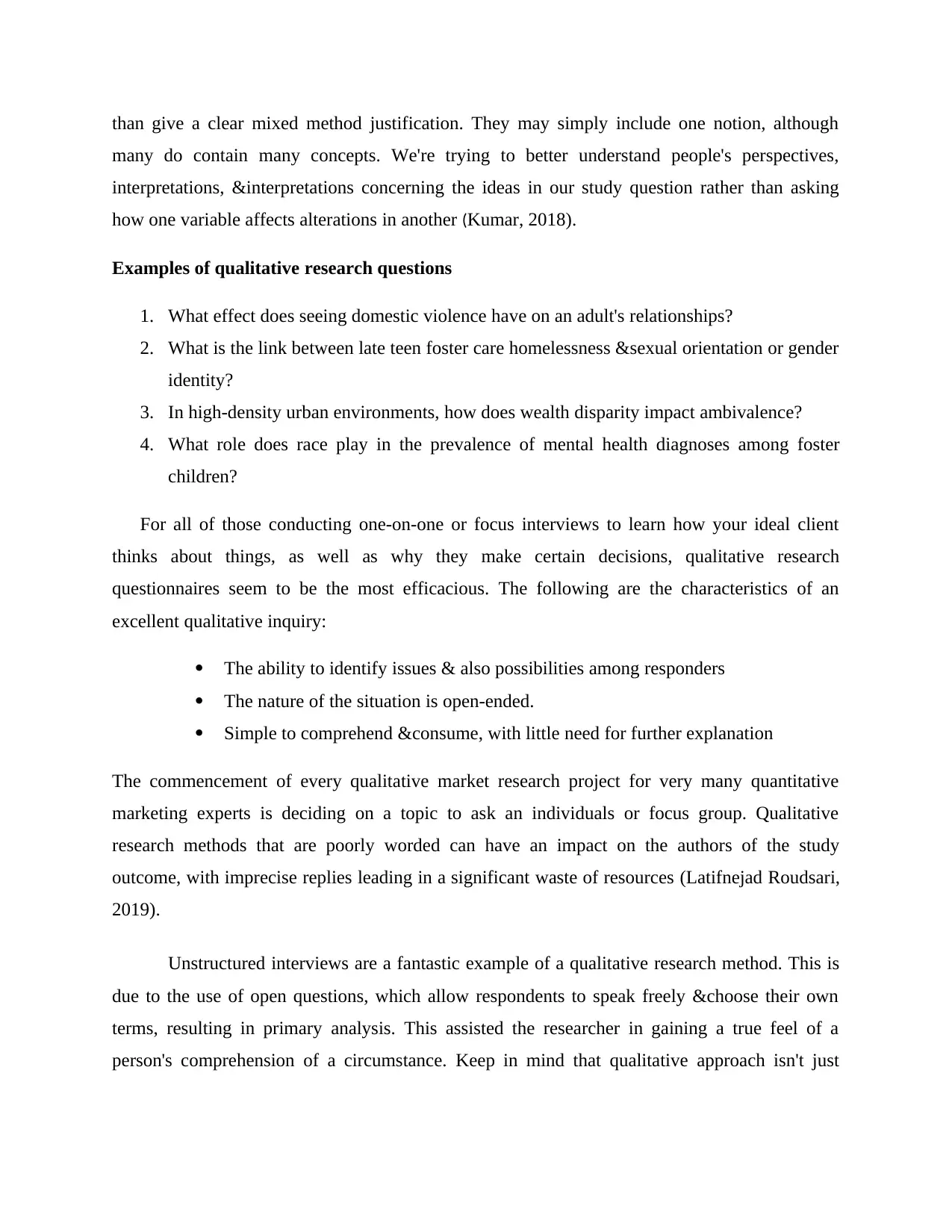
than give a clear mixed method justification. They may simply include one notion, although
many do contain many concepts. We're trying to better understand people's perspectives,
interpretations, &interpretations concerning the ideas in our study question rather than asking
how one variable affects alterations in another (Kumar, 2018).
Examples of qualitative research questions
1. What effect does seeing domestic violence have on an adult's relationships?
2. What is the link between late teen foster care homelessness &sexual orientation or gender
identity?
3. In high-density urban environments, how does wealth disparity impact ambivalence?
4. What role does race play in the prevalence of mental health diagnoses among foster
children?
For all of those conducting one-on-one or focus interviews to learn how your ideal client
thinks about things, as well as why they make certain decisions, qualitative research
questionnaires seem to be the most efficacious. The following are the characteristics of an
excellent qualitative inquiry:
The ability to identify issues & also possibilities among responders
The nature of the situation is open-ended.
Simple to comprehend &consume, with little need for further explanation
The commencement of every qualitative market research project for very many quantitative
marketing experts is deciding on a topic to ask an individuals or focus group. Qualitative
research methods that are poorly worded can have an impact on the authors of the study
outcome, with imprecise replies leading in a significant waste of resources (Latifnejad Roudsari,
2019).
Unstructured interviews are a fantastic example of a qualitative research method. This is
due to the use of open questions, which allow respondents to speak freely &choose their own
terms, resulting in primary analysis. This assisted the researcher in gaining a true feel of a
person's comprehension of a circumstance. Keep in mind that qualitative approach isn't just
many do contain many concepts. We're trying to better understand people's perspectives,
interpretations, &interpretations concerning the ideas in our study question rather than asking
how one variable affects alterations in another (Kumar, 2018).
Examples of qualitative research questions
1. What effect does seeing domestic violence have on an adult's relationships?
2. What is the link between late teen foster care homelessness &sexual orientation or gender
identity?
3. In high-density urban environments, how does wealth disparity impact ambivalence?
4. What role does race play in the prevalence of mental health diagnoses among foster
children?
For all of those conducting one-on-one or focus interviews to learn how your ideal client
thinks about things, as well as why they make certain decisions, qualitative research
questionnaires seem to be the most efficacious. The following are the characteristics of an
excellent qualitative inquiry:
The ability to identify issues & also possibilities among responders
The nature of the situation is open-ended.
Simple to comprehend &consume, with little need for further explanation
The commencement of every qualitative market research project for very many quantitative
marketing experts is deciding on a topic to ask an individuals or focus group. Qualitative
research methods that are poorly worded can have an impact on the authors of the study
outcome, with imprecise replies leading in a significant waste of resources (Latifnejad Roudsari,
2019).
Unstructured interviews are a fantastic example of a qualitative research method. This is
due to the use of open questions, which allow respondents to speak freely &choose their own
terms, resulting in primary analysis. This assisted the researcher in gaining a true feel of a
person's comprehension of a circumstance. Keep in mind that qualitative approach isn't just
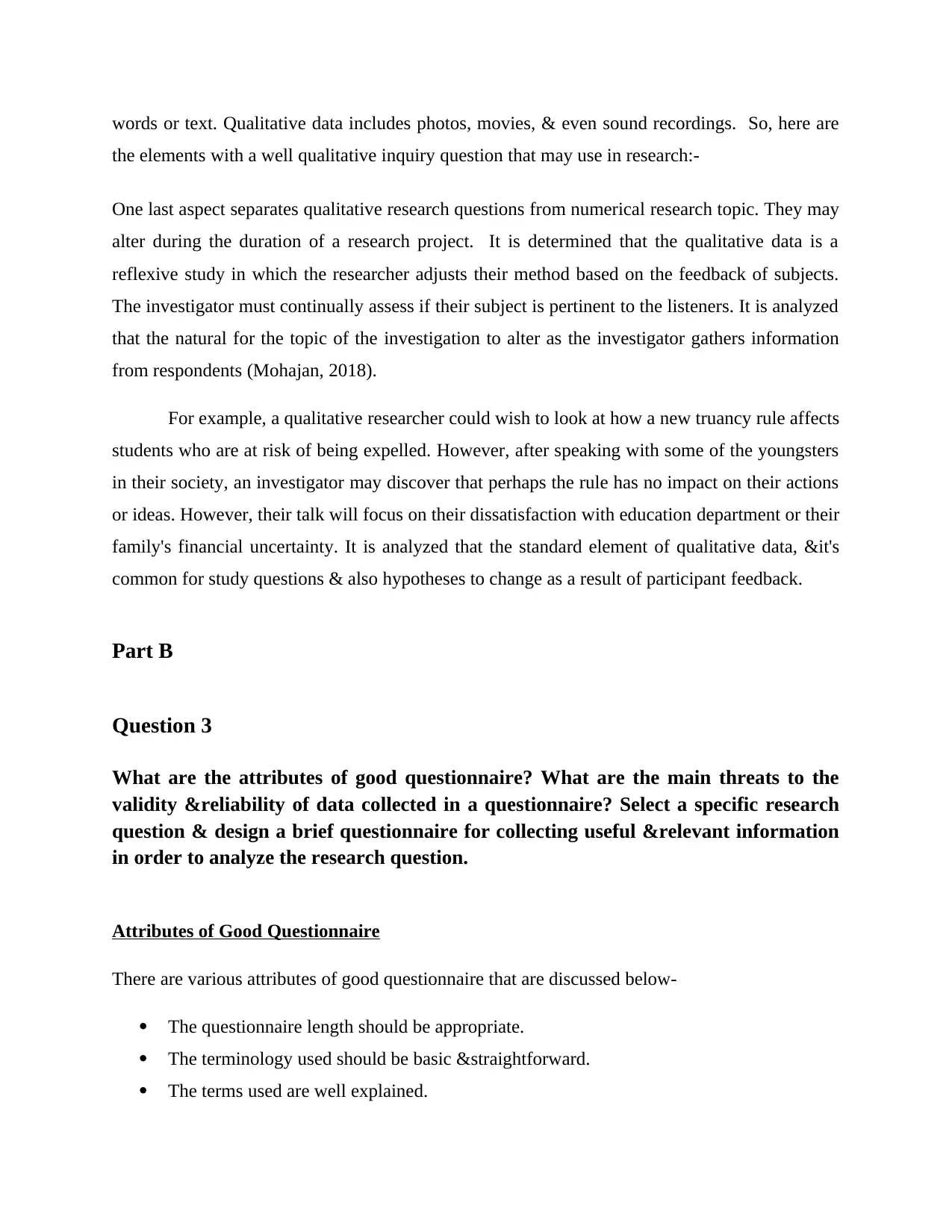
words or text. Qualitative data includes photos, movies, & even sound recordings. So, here are
the elements with a well qualitative inquiry question that may use in research:-
One last aspect separates qualitative research questions from numerical research topic. They may
alter during the duration of a research project. It is determined that the qualitative data is a
reflexive study in which the researcher adjusts their method based on the feedback of subjects.
The investigator must continually assess if their subject is pertinent to the listeners. It is analyzed
that the natural for the topic of the investigation to alter as the investigator gathers information
from respondents (Mohajan, 2018).
For example, a qualitative researcher could wish to look at how a new truancy rule affects
students who are at risk of being expelled. However, after speaking with some of the youngsters
in their society, an investigator may discover that perhaps the rule has no impact on their actions
or ideas. However, their talk will focus on their dissatisfaction with education department or their
family's financial uncertainty. It is analyzed that the standard element of qualitative data, &it's
common for study questions & also hypotheses to change as a result of participant feedback.
Part B
Question 3
What are the attributes of good questionnaire? What are the main threats to the
validity &reliability of data collected in a questionnaire? Select a specific research
question & design a brief questionnaire for collecting useful &relevant information
in order to analyze the research question.
Attributes of Good Questionnaire
There are various attributes of good questionnaire that are discussed below-
The questionnaire length should be appropriate.
The terminology used should be basic &straightforward.
The terms used are well explained.
the elements with a well qualitative inquiry question that may use in research:-
One last aspect separates qualitative research questions from numerical research topic. They may
alter during the duration of a research project. It is determined that the qualitative data is a
reflexive study in which the researcher adjusts their method based on the feedback of subjects.
The investigator must continually assess if their subject is pertinent to the listeners. It is analyzed
that the natural for the topic of the investigation to alter as the investigator gathers information
from respondents (Mohajan, 2018).
For example, a qualitative researcher could wish to look at how a new truancy rule affects
students who are at risk of being expelled. However, after speaking with some of the youngsters
in their society, an investigator may discover that perhaps the rule has no impact on their actions
or ideas. However, their talk will focus on their dissatisfaction with education department or their
family's financial uncertainty. It is analyzed that the standard element of qualitative data, &it's
common for study questions & also hypotheses to change as a result of participant feedback.
Part B
Question 3
What are the attributes of good questionnaire? What are the main threats to the
validity &reliability of data collected in a questionnaire? Select a specific research
question & design a brief questionnaire for collecting useful &relevant information
in order to analyze the research question.
Attributes of Good Questionnaire
There are various attributes of good questionnaire that are discussed below-
The questionnaire length should be appropriate.
The terminology used should be basic &straightforward.
The terms used are well explained.
⊘ This is a preview!⊘
Do you want full access?
Subscribe today to unlock all pages.

Trusted by 1+ million students worldwide
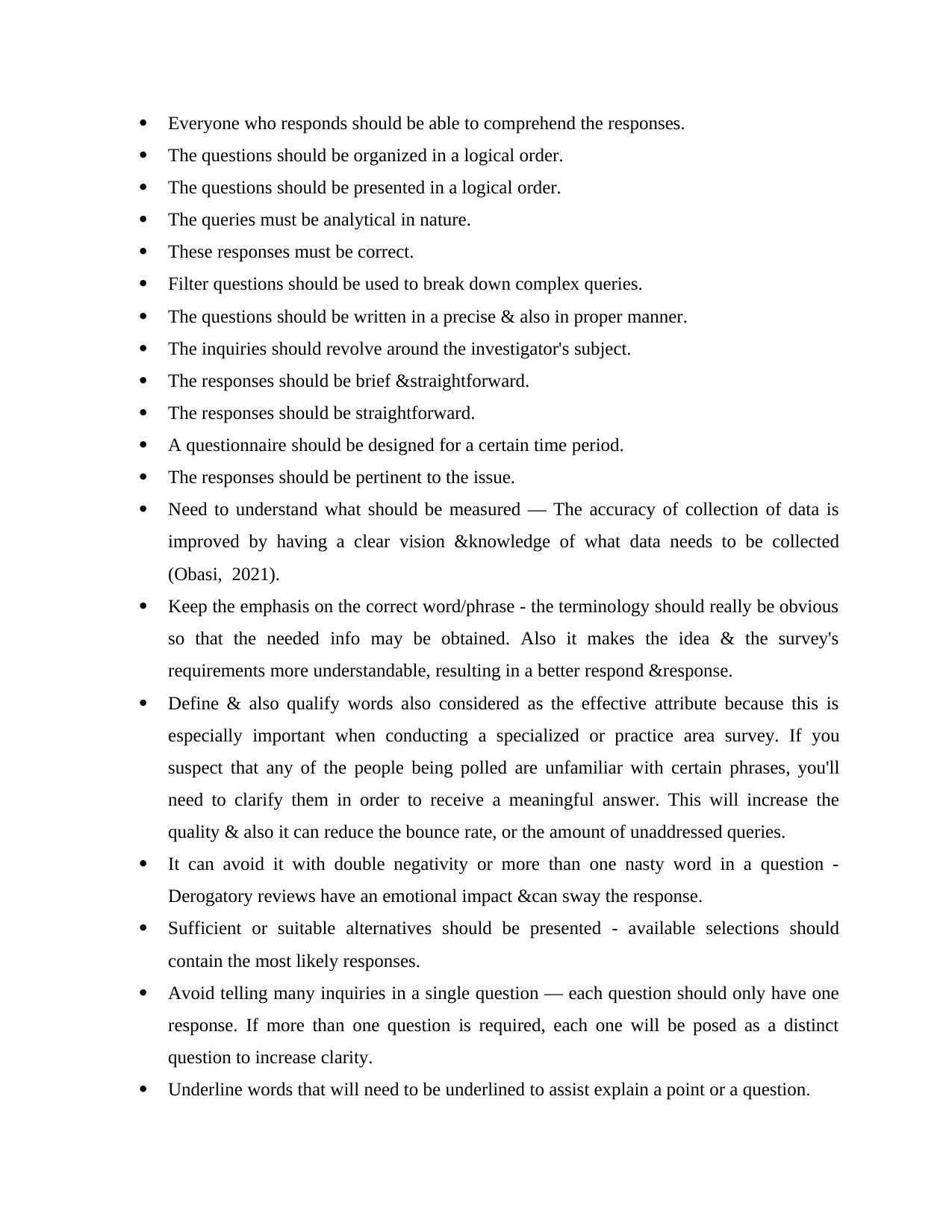
Everyone who responds should be able to comprehend the responses.
The questions should be organized in a logical order.
The questions should be presented in a logical order.
The queries must be analytical in nature.
These responses must be correct.
Filter questions should be used to break down complex queries.
The questions should be written in a precise & also in proper manner.
The inquiries should revolve around the investigator's subject.
The responses should be brief &straightforward.
The responses should be straightforward.
A questionnaire should be designed for a certain time period.
The responses should be pertinent to the issue.
Need to understand what should be measured — The accuracy of collection of data is
improved by having a clear vision &knowledge of what data needs to be collected
(Obasi, 2021).
Keep the emphasis on the correct word/phrase - the terminology should really be obvious
so that the needed info may be obtained. Also it makes the idea & the survey's
requirements more understandable, resulting in a better respond &response.
Define & also qualify words also considered as the effective attribute because this is
especially important when conducting a specialized or practice area survey. If you
suspect that any of the people being polled are unfamiliar with certain phrases, you'll
need to clarify them in order to receive a meaningful answer. This will increase the
quality & also it can reduce the bounce rate, or the amount of unaddressed queries.
It can avoid it with double negativity or more than one nasty word in a question -
Derogatory reviews have an emotional impact &can sway the response.
Sufficient or suitable alternatives should be presented - available selections should
contain the most likely responses.
Avoid telling many inquiries in a single question — each question should only have one
response. If more than one question is required, each one will be posed as a distinct
question to increase clarity.
Underline words that will need to be underlined to assist explain a point or a question.
The questions should be organized in a logical order.
The questions should be presented in a logical order.
The queries must be analytical in nature.
These responses must be correct.
Filter questions should be used to break down complex queries.
The questions should be written in a precise & also in proper manner.
The inquiries should revolve around the investigator's subject.
The responses should be brief &straightforward.
The responses should be straightforward.
A questionnaire should be designed for a certain time period.
The responses should be pertinent to the issue.
Need to understand what should be measured — The accuracy of collection of data is
improved by having a clear vision &knowledge of what data needs to be collected
(Obasi, 2021).
Keep the emphasis on the correct word/phrase - the terminology should really be obvious
so that the needed info may be obtained. Also it makes the idea & the survey's
requirements more understandable, resulting in a better respond &response.
Define & also qualify words also considered as the effective attribute because this is
especially important when conducting a specialized or practice area survey. If you
suspect that any of the people being polled are unfamiliar with certain phrases, you'll
need to clarify them in order to receive a meaningful answer. This will increase the
quality & also it can reduce the bounce rate, or the amount of unaddressed queries.
It can avoid it with double negativity or more than one nasty word in a question -
Derogatory reviews have an emotional impact &can sway the response.
Sufficient or suitable alternatives should be presented - available selections should
contain the most likely responses.
Avoid telling many inquiries in a single question — each question should only have one
response. If more than one question is required, each one will be posed as a distinct
question to increase clarity.
Underline words that will need to be underlined to assist explain a point or a question.
Paraphrase This Document
Need a fresh take? Get an instant paraphrase of this document with our AI Paraphraser
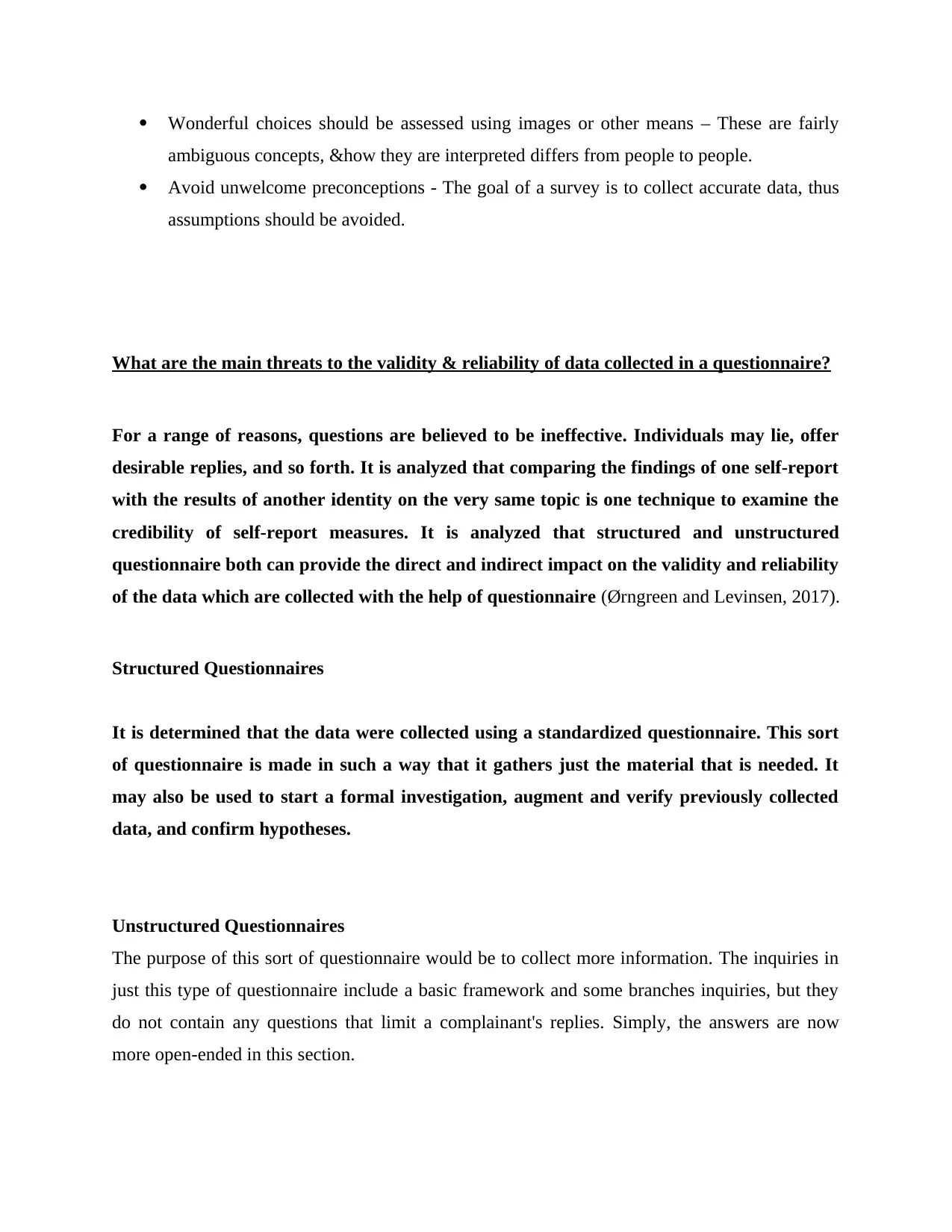
Wonderful choices should be assessed using images or other means – These are fairly
ambiguous concepts, &how they are interpreted differs from people to people.
Avoid unwelcome preconceptions - The goal of a survey is to collect accurate data, thus
assumptions should be avoided.
What are the main threats to the validity & reliability of data collected in a questionnaire?
For a range of reasons, questions are believed to be ineffective. Individuals may lie, offer
desirable replies, and so forth. It is analyzed that comparing the findings of one self-report
with the results of another identity on the very same topic is one technique to examine the
credibility of self-report measures. It is analyzed that structured and unstructured
questionnaire both can provide the direct and indirect impact on the validity and reliability
of the data which are collected with the help of questionnaire (Ørngreen and Levinsen, 2017).
Structured Questionnaires
It is determined that the data were collected using a standardized questionnaire. This sort
of questionnaire is made in such a way that it gathers just the material that is needed. It
may also be used to start a formal investigation, augment and verify previously collected
data, and confirm hypotheses.
Unstructured Questionnaires
The purpose of this sort of questionnaire would be to collect more information. The inquiries in
just this type of questionnaire include a basic framework and some branches inquiries, but they
do not contain any questions that limit a complainant's replies. Simply, the answers are now
more open-ended in this section.
ambiguous concepts, &how they are interpreted differs from people to people.
Avoid unwelcome preconceptions - The goal of a survey is to collect accurate data, thus
assumptions should be avoided.
What are the main threats to the validity & reliability of data collected in a questionnaire?
For a range of reasons, questions are believed to be ineffective. Individuals may lie, offer
desirable replies, and so forth. It is analyzed that comparing the findings of one self-report
with the results of another identity on the very same topic is one technique to examine the
credibility of self-report measures. It is analyzed that structured and unstructured
questionnaire both can provide the direct and indirect impact on the validity and reliability
of the data which are collected with the help of questionnaire (Ørngreen and Levinsen, 2017).
Structured Questionnaires
It is determined that the data were collected using a standardized questionnaire. This sort
of questionnaire is made in such a way that it gathers just the material that is needed. It
may also be used to start a formal investigation, augment and verify previously collected
data, and confirm hypotheses.
Unstructured Questionnaires
The purpose of this sort of questionnaire would be to collect more information. The inquiries in
just this type of questionnaire include a basic framework and some branches inquiries, but they
do not contain any questions that limit a complainant's replies. Simply, the answers are now
more open-ended in this section.
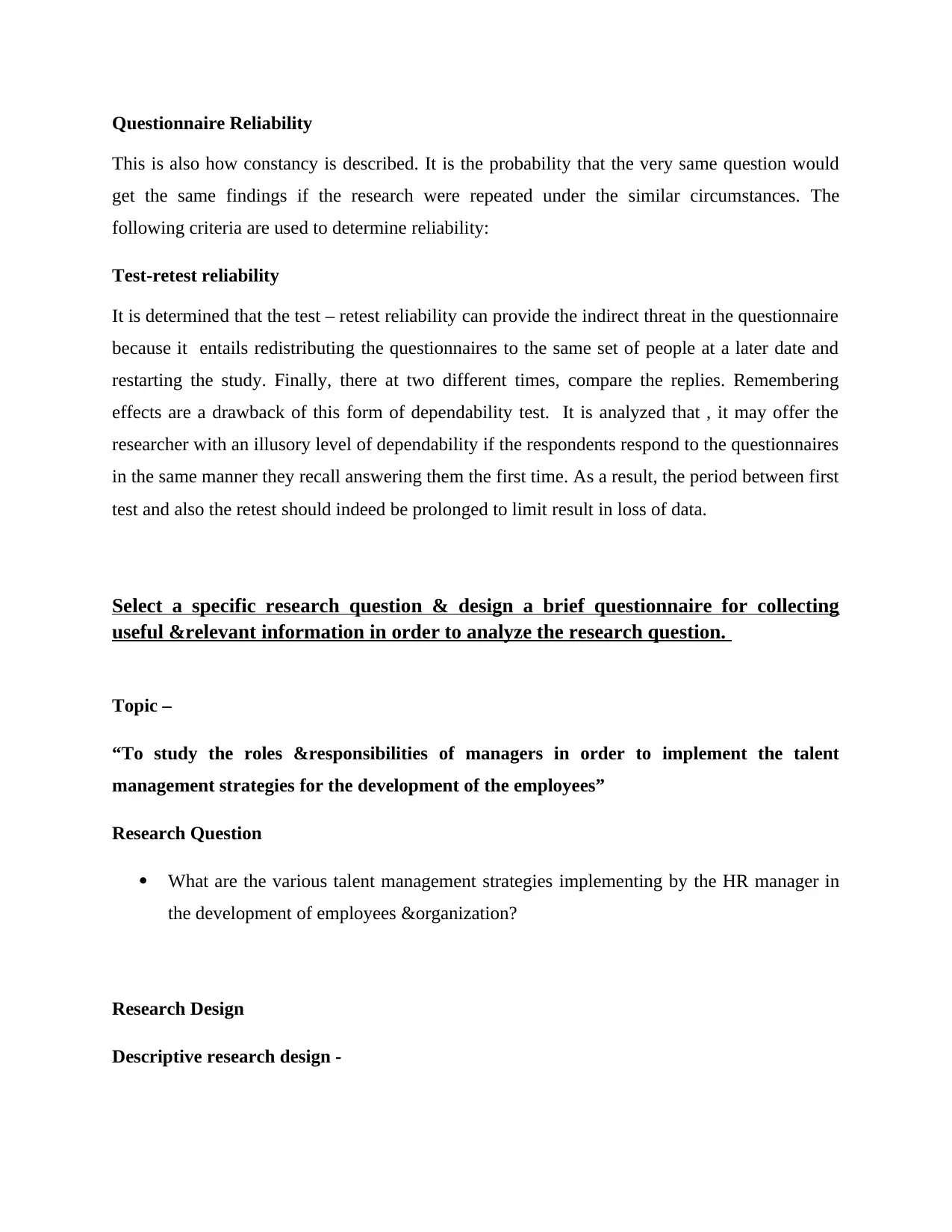
Questionnaire Reliability
This is also how constancy is described. It is the probability that the very same question would
get the same findings if the research were repeated under the similar circumstances. The
following criteria are used to determine reliability:
Test-retest reliability
It is determined that the test – retest reliability can provide the indirect threat in the questionnaire
because it entails redistributing the questionnaires to the same set of people at a later date and
restarting the study. Finally, there at two different times, compare the replies. Remembering
effects are a drawback of this form of dependability test. It is analyzed that , it may offer the
researcher with an illusory level of dependability if the respondents respond to the questionnaires
in the same manner they recall answering them the first time. As a result, the period between first
test and also the retest should indeed be prolonged to limit result in loss of data.
Select a specific research question & design a brief questionnaire for collecting
useful &relevant information in order to analyze the research question.
Topic –
“To study the roles &responsibilities of managers in order to implement the talent
management strategies for the development of the employees”
Research Question
What are the various talent management strategies implementing by the HR manager in
the development of employees &organization?
Research Design
Descriptive research design -
This is also how constancy is described. It is the probability that the very same question would
get the same findings if the research were repeated under the similar circumstances. The
following criteria are used to determine reliability:
Test-retest reliability
It is determined that the test – retest reliability can provide the indirect threat in the questionnaire
because it entails redistributing the questionnaires to the same set of people at a later date and
restarting the study. Finally, there at two different times, compare the replies. Remembering
effects are a drawback of this form of dependability test. It is analyzed that , it may offer the
researcher with an illusory level of dependability if the respondents respond to the questionnaires
in the same manner they recall answering them the first time. As a result, the period between first
test and also the retest should indeed be prolonged to limit result in loss of data.
Select a specific research question & design a brief questionnaire for collecting
useful &relevant information in order to analyze the research question.
Topic –
“To study the roles &responsibilities of managers in order to implement the talent
management strategies for the development of the employees”
Research Question
What are the various talent management strategies implementing by the HR manager in
the development of employees &organization?
Research Design
Descriptive research design -
⊘ This is a preview!⊘
Do you want full access?
Subscribe today to unlock all pages.

Trusted by 1+ million students worldwide

Descriptive study is to represent the current state of a variable that has been established. These
studies are intended to give extensive data on phenomena. The investigator normally does not
start with a premise, but will most likely create one after gathering evidence. The model is
formulated by analyzing & synthesizing the data. Comprehensive data collection necessitates the
thorough identification of the units to be investigated as well as the accurate measurement of
each variable (Pai, Yeh and Tang, 2018).
Experimental research design -
Exploratory design, commonly termed actual experimental, employs the academic method to
determine the start causing relation among a set of components that make up a study. The
genuine experiment is frequently mistaken for a laboratory research, although this wasn't always
the case; the laboratory environment has no bearing on the true experiment. Any research in
which all other variables except one are identified &controlled is considered a valid
experimental. To assess the impact on the dependent variables, an independent variable is
changed.
studies are intended to give extensive data on phenomena. The investigator normally does not
start with a premise, but will most likely create one after gathering evidence. The model is
formulated by analyzing & synthesizing the data. Comprehensive data collection necessitates the
thorough identification of the units to be investigated as well as the accurate measurement of
each variable (Pai, Yeh and Tang, 2018).
Experimental research design -
Exploratory design, commonly termed actual experimental, employs the academic method to
determine the start causing relation among a set of components that make up a study. The
genuine experiment is frequently mistaken for a laboratory research, although this wasn't always
the case; the laboratory environment has no bearing on the true experiment. Any research in
which all other variables except one are identified &controlled is considered a valid
experimental. To assess the impact on the dependent variables, an independent variable is
changed.
Paraphrase This Document
Need a fresh take? Get an instant paraphrase of this document with our AI Paraphraser
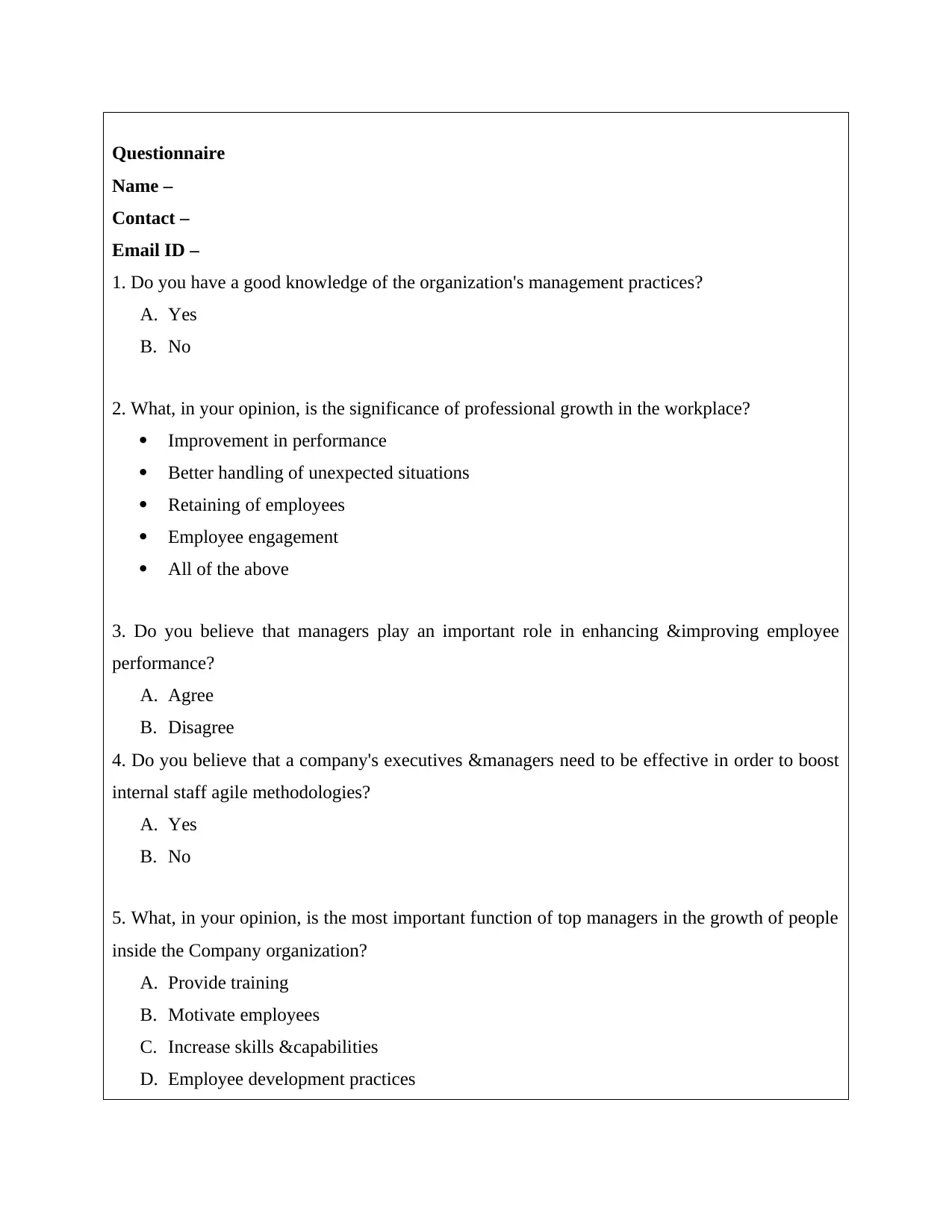
Questionnaire
Name –
Contact –
Email ID –
1. Do you have a good knowledge of the organization's management practices?
A. Yes
B. No
2. What, in your opinion, is the significance of professional growth in the workplace?
Improvement in performance
Better handling of unexpected situations
Retaining of employees
Employee engagement
All of the above
3. Do you believe that managers play an important role in enhancing &improving employee
performance?
A. Agree
B. Disagree
4. Do you believe that a company's executives &managers need to be effective in order to boost
internal staff agile methodologies?
A. Yes
B. No
5. What, in your opinion, is the most important function of top managers in the growth of people
inside the Company organization?
A. Provide training
B. Motivate employees
C. Increase skills &capabilities
D. Employee development practices
Name –
Contact –
Email ID –
1. Do you have a good knowledge of the organization's management practices?
A. Yes
B. No
2. What, in your opinion, is the significance of professional growth in the workplace?
Improvement in performance
Better handling of unexpected situations
Retaining of employees
Employee engagement
All of the above
3. Do you believe that managers play an important role in enhancing &improving employee
performance?
A. Agree
B. Disagree
4. Do you believe that a company's executives &managers need to be effective in order to boost
internal staff agile methodologies?
A. Yes
B. No
5. What, in your opinion, is the most important function of top managers in the growth of people
inside the Company organization?
A. Provide training
B. Motivate employees
C. Increase skills &capabilities
D. Employee development practices

E. All of the above
6. What are the hurdles that leaders & managers have while employing staff motivation tactics to
grow people inside the company working environment, in your opinion?.
A. Low self confidence
B. Anxiety
C. Lack of interest
D. Fear of failure
E. All of the above
6. What are the hurdles that leaders & managers have while employing staff motivation tactics to
grow people inside the company working environment, in your opinion?.
A. Low self confidence
B. Anxiety
C. Lack of interest
D. Fear of failure
E. All of the above
⊘ This is a preview!⊘
Do you want full access?
Subscribe today to unlock all pages.

Trusted by 1+ million students worldwide
1 out of 13
Related Documents
Your All-in-One AI-Powered Toolkit for Academic Success.
+13062052269
info@desklib.com
Available 24*7 on WhatsApp / Email
![[object Object]](/_next/static/media/star-bottom.7253800d.svg)
Unlock your academic potential
Copyright © 2020–2025 A2Z Services. All Rights Reserved. Developed and managed by ZUCOL.


